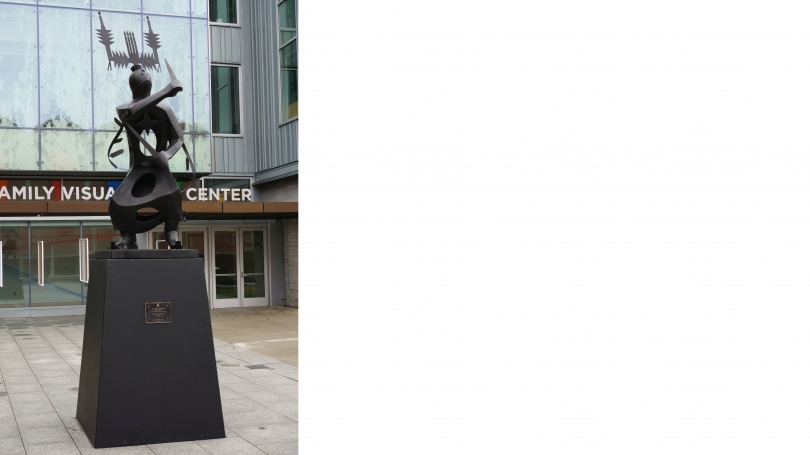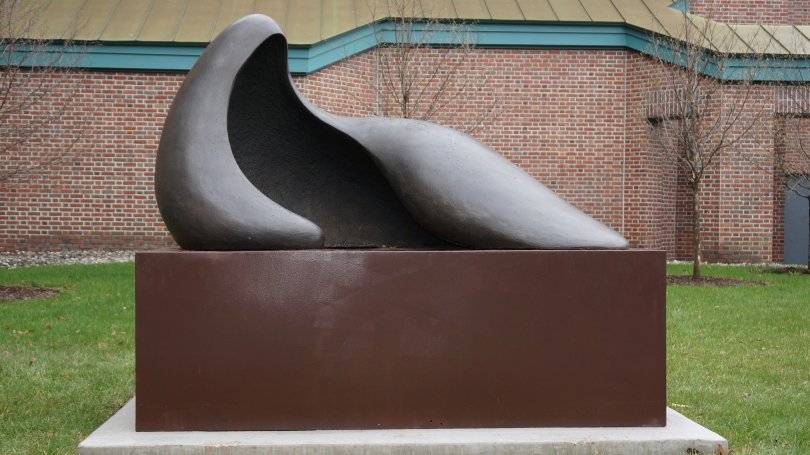Allan Houser: A Centennial Exhibition
Hood Quarterly, spring 2014
Katharine Hart, Senior Curator of Collections and Barbara C. and Harvey P. Hood Curator of Academic Programming
I could never turn away from my history . . . That's the part of me that made me what I am now. That strength that I have is my pride in who I am. My heritage.
—Allan Houser
This May, the Hood Museum of Art installs five sculptures by Native American artist Allan Houser (1914–1994) in the Maffei Arts Plaza, adjacent to the museum and the Black Family Visual Arts Center. These sculptures represent a cross-section of this renowned artist's large threedimensional work from the years 1986 to 1992. There will also be two sculptures by Houser on view in the museum this spring—one in the downstairs galleries, and the other in the exhibition In Residence: Contemporary Artists at Dartmouth, which is devoted to the long and exemplary history of the Artist-in-Residence Program at the college. Houser was artist-in-residence in 1979, and the Hood collection includes several sculptures by him, two donated by Harry Lewis, Class of 1955, a third by the Class of 1962, and a fourth by May and Dave Raynolds, Class of 1949, who are also major funders of Dartmouth's centenary tribute to Houser.
The sculpture given by the Raynoldses, titled Peaceful Serenity, is permanently on view on the lawn of north campus's Sherman House, home of the Native American Studies Department. Lastly, in September of this year, the Studio Art Exhibition Program and the Hood will present an exhibition of Houser's drawings and smaller sculpture in Strauss Gallery at the Hopkins Center, curated by Gerald Auten, director of the exhibition program for the Studio Art Department and a senior lecturer there. Allan Houser: A Centennial Exhibition is a tribute to the artist that was first suggested to the museum by Dave Raynolds, who has long been a champion of Houser's work. The outdoor sculpture and drawings from the artist's estate are lent to the museum by the Houser Foundation, Inc., under the guidance of Dave Rettig, Class of 1975, who is the curator of collections at the foundation.
Allan Houser, one of the bestknown Native American artists of the twentieth century, continues to be an influential figure in the field of Southwestern sculpture in the United States. He was a member of the Chiricahua Apache, a group that was imprisoned for twenty-seven years after the surrender of Geronimo. Houser was the first child born out of captivity after they were released; his mother had been born while the group was still incarcerated. He enrolled in painting school at the Santa Fe Indian School as a young man and began his career as a mural painter at the end of the Depression. His first marble carving was a monument to the Native Americans from the Haskell School in Lawrence, Kansas, who died in World War II. In the early 1950s, he began teaching art at the Inter-Mountain Indian School in Brigham City, Utah. Eleven years later, he became a professor at the Institute of American Indian Arts in Santa Fe, where he primarily taught sculpture, finally retiring in 1975 to pursue his artistic career. As a sculptor, he worked in stone and bronze and, occasionally, wood.
The five sculptures in this exhibition demonstrate Houser's distinctive achievements in the genre. While he is well known for his Native American subjects, such as Abstract Crown Dancer I (1992) (slides 2 and 3) and Morning Solitude (1989) (slide 4), he is less associated with abstract modernism—this despite the fact that he was equally invested, particularly in his later career, in the creation of simpler forms. In both modes of expression, he sought a sense of the enduring spirit and centered being. He related his work to music: "I put this rhythm into it, the beautiful rhythms of song my dad used to sing and stories he told about. This way, the feelings I have are getting across, I hope—the sympathy I have for the Indians, and the dignity I see in them." This is as true for his elegant abstractions as for his sculptures that depicted Native American subjects.
It is a lesser-known fact that Houser had great facility as a draftsman. He experimented with ideas for sculptural works in his sketchbooks, as will be clear from the drawings that will be on view in the fall. One such drawing (see slide 1) demonstrates his expressive range—the biomorphic sculpture at the top right reveals his engagement with modernism and is directly reflected in the sculpture Watercarrier (1986), which will be on display this spring. Houser also created many images inspired by Native American and Southwestern life, and his skill, coupled with the joy he took in working through his ideas on paper, is abundantly apparent.
It is fitting that Dartmouth College joins tributes across the nation to a remarkable creative spirit who gave so much to the students he mentored and left behind an artistic legacy of work that is recognized internationally by art historians and museum curators of modern and contemporary American art.
The installation on the Maffei Arts Plaza is on view from May 11, 2014, to May 10, 2015. The Strauss Gallery exhibition will run from September 23 to November 23, 2014. This article draws from W. Jackson Rushing III's 2004 book Allan Houser: An American Master (Chiricahua Apache, 1914–1994). Rushing, who is Eugene B. Adkins Presidential Professor of Art History and Mary Lou Milner Carver Chair in Native American Art at the School of Art and Art History at the University of Oklahoma, will deliver the Dr. Allen W. Root Contemporary Art Distinguished Lecture on Houser's work and legacy on October 10.
This exhibition was organized by the Hood Museum of Art and was generously supported by Mary Alice Kean Raynolds and David R. W. Raynolds, Dartmouth Class of 1949, Carol Fishberg and Franklin Z. Davidson, Dartmouth Class of 1955, in memory of Gerald D. Kleinman, Dartmouth Class of 1955, and Lewis R. Weintraub, Dartmouth Class of 1955, and the William B. Jaffe and Evelyn A. Hall Fund.
Related Exhibitions
- Allan Houser: A Centennial Exhibition
- In Residence: Contemporary Artists at Dartmouth
- Native American Art at Dartmouth: Highlights from the Hood Museum of Art




